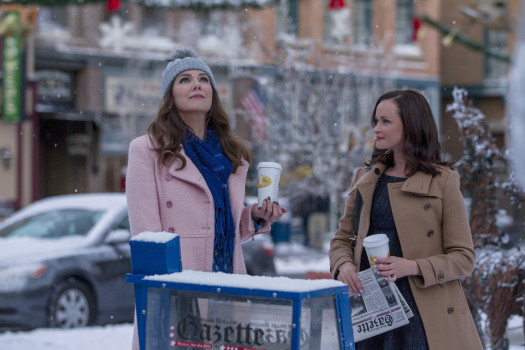When the television series Gilmore Girls appeared in its entirety on Netflix in October 2014, fans new and old were prompted to binge watch the WB classic. For seven seasons, the show followed former teen mom Lorelai Gilmore (Lauren Graham) and her teenage daughter and best friend Rory (Alexis Bledel) as they built a relationship with Lorelai’s parents Emily (Kelly Bishop) and Richard (Edward Herrmann), supported Rory’s journey from prep school Chilton to Yale University, managed their extremely flawed romantic relationships, and made their home in the small, quirky town of Stars Hollow, Connecticut. In the late 90’s and early 2000’s, the series was known for its Sorkin-esque fast-talking characters, numerous pop culture references, and entitled, yet endearing leading ladies. When the show found a new home on the popular online streaming website, it also found a renewed place in pop culture, turning up in Buzzfeed lists and quizzes, Tumblr posts, and even the podcast “Gilmore Guys” in which two twenty-something men recap every episode.
The cultural revival of the show hit its apex when an actual revival was announced earlier this year by Netflix. Finally, fans could revisit all of their favourite Stars Hollow characters, learn where Rory’s journalism career had taken her, and, most importantly, hear the final four words of the show that creator and executive producer Amy Sherman-Palladino had promised them a decade ago. The full main cast was slated to return, aside from the late Herrmann, and Melissa McCarthy who played Lorelai’s best friend Sookie St. James. Sherman-Palladino and her husband, executive producer Daniel Palladino, who were absent for last season of the show, were both on board. Expectations, unsurprisingly, were high.
Rather than filming a full new season of the show, Netflix announced that the revival would be a mini-series of hour and a half long episodes featuring four seasons in the lives of the Gilmores, appropriately titled Gilmore Girls: A Year in the Life. All four episodes were released on November 25, coaxing fans away from the mall on Black Friday to sit in front of their computers and finally see what became of their beloved Gilmores.
A Year in the Life opens with iconic quotes from the original show’s seven seasons, immediately identifying itself as a show intended for fans of the original series. Some scenes that long-time fans will find exciting, like Kirk’s second short film, or the Life and Death Brigade’s homage to Across the Universe, will be just plain confusing to new viewers. That’s not to say that there isn’t plenty in this series for non-fans and Gilmore Girls fans (or, as I prefer to call us, “Gillies”) alike to be enjoy. From Paris Geller’s (Liza Weil) freak out in a Chilton bathroom, to Lorelai’s decision to do Wild (the book, not the movie), the series is as clever in its humor as the original. Even McCarthy makes a brief comic appearance in the fourth episode.
The show generally maintains a balance of witty comedy and emotional drama, including the kind of mother-daughter (namely Lorelai versus Emily and Lorelai versus Rory) shouting matches that are never overdone, but hit just the right note. All of the familial arguments are earned, as are their resolutions, after a thoughtful set-up and resolution by Sherman-Palladino. Most impressive is how Sherman-Palladino handles Herrmann’s death. He isn’t forgotten, in fact the Gilmore patriarch has an immense presence in the new show, mostly in the form of wall-sized portrait hanging in Emily’s house. We are shown scenes from his funeral in the first episode, but he isn’t seen until the final episode, in which Rory walks through her grandparents’ house and imagines him still with her. While the scene could have been trite, it fits the show’s ending well, giving viewers closure with Richard’s character.
Providing closure to character arcs is one element that Sherman-Palladino has a difficult time with in this iteration of the series. She has stayed true to the original characters in the revival, and provides rich arcs for both Emily and Lorelai. But Rory does not seem to have grown up between the ages of 22 and 32. While her morals were always somewhat loose (Rory loses her virginity to her married ex-boyfriend and there’s that one time she steals a yacht), it surprised me to find her in an ongoing affair with an engaged ex-boyfriend while she also cheats on her “forgettable” boyfriend.
Instead of the hard-working Rory who once made articles on boring subjects for her high school newspaper shine with creativity, we are introduced to a Rory with only a few published articles under her belt, who spends her free time jetting between London and Connecticut to carry on her affair. The formerly tenacious character thinks it’s beneath her to write for online media and gives up an opportunity writing a piece for Condé Nast after one day. The privilege that has followed her from Chilton to Yale to her first reporting job has obviously come to an end. Even in the last episode when she decides to write a book, she does not appear to have grown at all. And then there’s the final four words.
I won’t spoil them for you, but I will say that they make it clear that Rory has a lot more growing to do. Does this mean more episodes? Opinions differ, after all, these were the intended final four words of the show. Personally, I think a return would not only be the best way to flesh out Rory’s character arc, but it would be great for television in general. Despite Rory’s lack of redemption at the finale, she, Lorelai and Emily remain three of the most complex and nuanced female characters written for television in the 2000s, and I would welcome a return. Where they lead, I will follow.

